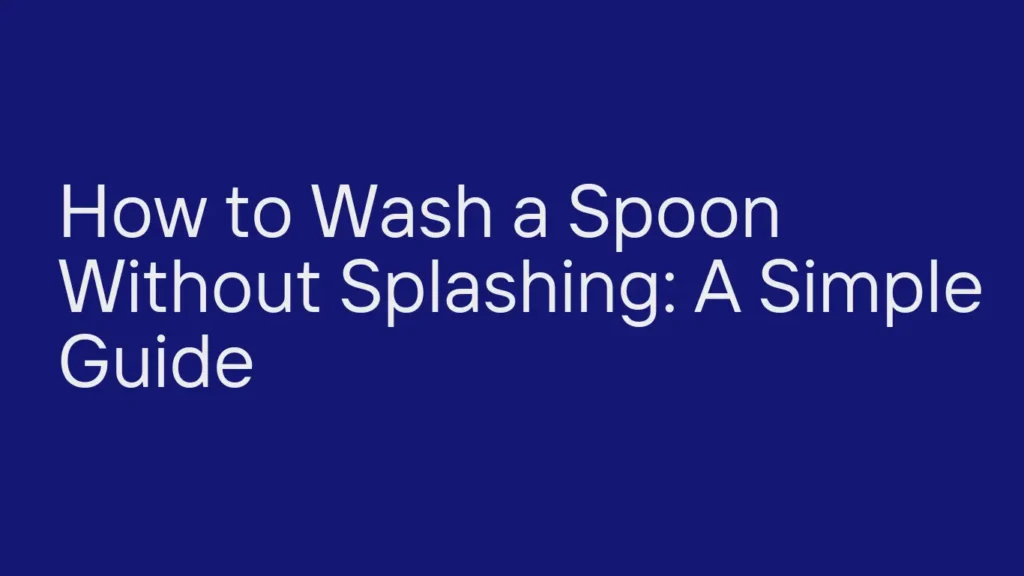Washing dishes is a daily chore that can sometimes turn into a messy affair, especially when it comes to utensils like spoons. If you’re tired of water and soap splashing all over your kitchen, follow this easy guide on how to wash a spoon without splashing. We’ll cover everything from setting up your workspace to the best techniques for splash-free dishwashing.
Why Does Splashing Happen?
Before we get into how to wash a spoon without splashing, let’s understand why splashing occurs:
- Abrupt Movements: Dropping or quickly plunging the spoon into the water can cause splashes.
- High-Pressure Water: Using a strong stream of water can stir up bubbles and cause splashing.
- Too Much Soap: Excess soap can create a lot of bubbles, leading to more splashes.
By addressing these issues, you can significantly reduce splashing and keep your kitchen cleaner.
Preparing Your Workspace for Splash-Free Washing
1. Set Up the Sink or Bowl
To wash a spoon without splashing, start with a well-prepared workspace:
- Fill with Warm, Soapy Water: Use warm water mixed with a small amount of dish soap. Warm water helps dissolve food and grease better. Be careful not to use too much soap to avoid creating excess bubbles.
- Choose the Right Cleaning Tools: Use a soft sponge or brush. Avoid harsh scrubbers that can produce more bubbles and splashes.
2. Keep the Sink Organized
- Avoid Overcrowding: Don’t fill the sink with too many dishes at once. Overcrowding can make it harder to control water flow and increase the chance of splashing. Wash items in smaller batches for better control.
How to Wash a Spoon Without Splashing
3. Submerge the Spoon Slowly
When you’re ready to wash your spoon, use these steps to avoid splashes:
- Lower the Spoon Gently: Instead of dropping it in, slowly lower the spoon into the water. This reduces the impact on the water’s surface and minimizes splashing.
- Position the Spoon Horizontally: Hold the spoon by the handle and place it horizontally into the water. This position helps in controlling water displacement and reduces splashes.
4. Scrub with Care
Now that your spoon is in the water, follow these steps for a splash-free scrub:
- Apply Gentle Pressure: Use a soft sponge or brush to scrub the spoon gently. Too much force can create bubbles and lead to splashing.
- Use Smooth, Consistent Strokes: Move the sponge or brush in smooth strokes from the base to the tip of the spoon. This method ensures effective cleaning while keeping splashes under control.
Rinsing the Spoon Without Making a Mess
5. Control the Water Flow
Rinsing is a crucial step in washing a spoon without splashing:
- Adjust the Faucet: Set your faucet to a low flow setting. A high-pressure stream can cause splashes. A gentle flow will help you rinse the spoon without making a mess.
- Tilt the Spoon Properly: Hold the spoon at a slight angle under the water. This allows water to run off smoothly and prevents pooling and splashing.
6. Use a Rinsing Bowl
If you have multiple items to rinse, consider using a separate bowl:
- Prepare a Rinsing Bowl: Fill it with clean water. Rinse the spoon in this bowl instead of under the faucet to better control water flow and reduce splashes.
- Gently Move the Spoon: Swirl the spoon gently in the rinsing bowl to remove soap and residue without creating splashes.
Drying the Spoon
7. Drying Techniques to Avoid Drips
After rinsing, you need to dry the spoon properly:
- Pat Dry with a Cloth: Use a clean, dry dish towel to gently pat the spoon dry. Avoid rubbing too hard to prevent water droplets from forming.
- Air Drying Option: Place the spoon on a drying rack and let it air dry. Ensure it’s positioned so water doesn’t drip onto other clean items.
Common Mistakes and How to Avoid Them
8. Avoid Overusing Soap
- Use the Right Amount: Too much soap can lead to excess bubbles and splashing. Use just enough soap to clean the spoon effectively.
9. Avoid Abrupt Movements
- Move Slowly: Sudden or jerky movements can cause water to splash. Move the spoon slowly and steadily to keep splashes to a minimum.
10. Manage Your Sink Space
- Avoid Overcrowding: An overcrowded sink makes it harder to control the washing process and increases the risk of splashing. Wash items in manageable batches.
Additional Tips for Splash-Free Dishwashing
11. Maintain Your Cleaning Tools
- Keep Tools Clean: Regularly clean your sponges and brushes to ensure they work effectively. A buildup of grime can affect water flow and increase splashing.
12. Use Splash Guards
- Consider a Splash Guard: If you struggle with splashing, a splash guard or high-sided dishpan can help contain splashes and keep your kitchen cleaner.
13. Practice and Patience
- Develop Your Technique: Like any skill, practice helps. The more you focus on gentle movements and controlled rinsing, the better you’ll become at washing a spoon without splashing.
The Benefits of Mastering Splash-Free Washing
14. Improved Efficiency
Learning how to wash a spoon without splashing can make your dishwashing routine more efficient. You’ll spend less time cleaning up messes and more time enjoying your meal.
15. Reduced Cleanup
By minimizing splashes, you’ll have less to clean up around your sink and counters. This means less time spent scrubbing and wiping surfaces.
16. Enhanced Satisfaction
Mastering the art of splash-free dishwashing adds a touch of professionalism to your routine and provides a sense of accomplishment.
Conclusion
Knowing how to wash a spoon without splashing can make a significant difference in your kitchen routine. By preparing your workspace, using the right techniques, and avoiding common mistakes, you can keep your dishwashing process clean and efficient. With practice, you’ll find that washing a spoon without splashing becomes second nature, leading to a tidier kitchen and a more enjoyable dishwashing experience.



